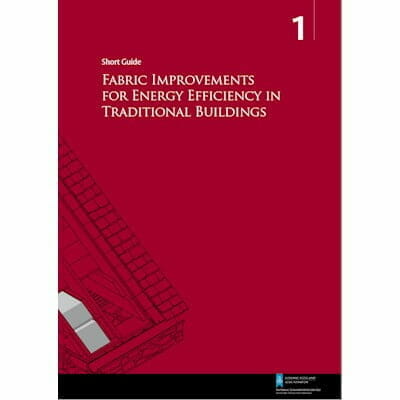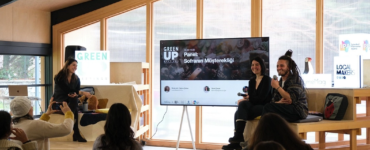Lila Angelaka, Senior Technical Officer of Technical Research Team from the Scottish Historical Environment, points out that the restoration of the historical environment and historical buildings, especially with local and traditional materials, reduces the carbon emitted during both procurement and production of the material: “We advocate to reuse of existing buildings and their refurbishment. Many traditional buildings have an inherent, in-built resilience to climate impacts”.
Interview: Burcu GENÇ Evangelia Angelaka, Senior Technical Officer Technical Research Team, Conservation.
Could you please briefly tell us about Historic Environment Scotland?
We are the lead public body set up to investigate, care for and promote Scotland’s historic environment. We are responsible for looking after more than 300 properties of national importance and we invest about £14 million a year in national and local organisations, supporting building repairs, ancient monuments, archaeological work, the Conservation Area Regeneration Scheme and the voluntary sector.
We are responsible for making and maintaining lists of nationally important; historic buildings, archaeological sites and monuments, gardens and designed landscapes, historic battlefields. We also provide advice and guidance on the impact of planning and development on Scotland’s historic environment.
We are active in a range of research fields, including surveying and recording, conservation science, care of traditional structures, energy improvements, physical and digital archiving, and measuring the historic environment’s social and economic value. Our conservation experts also provide guidance, training and technical research into Scotland’s built environment.
Through our outreach programme, we promote community and individual learning engagement with Scotland’s heritage. Through our work on making traditional and historic buildings more sustainable, we contribute to the Scottish Government’s strategy to tackle climate change and reduce Scotland’s carbon footprint.
The construction industry in Turkey, as you may already know, is like off-track. In Istanbul, for instance, the whole city seems like turns into a one big construction site. Because in Turkey we don’t transform old buildings or repair it to become more resilient. We demolish those and make new ones. Under these circumstances, urban and climate activists totally disagree with the idea of sustainable construction. You are the expert of transforming the historic environment to more energy-efficient, low-carbon and thus, make the cities more resilient. Do you think that the construction can be sustainable in this post-pandemic world? Do you have a guideline for these strategies?
Yes, and I generally feel there is an even greater emphasis on sustainable construction in a post-pandemic world. The pandemic reinforced the need for a wider look on how we approach sustainability, locality, resilience and durability, and inherently brought up the need to re-assess our existing buildings, how they are refurbished and used. For example, features of traditional and historic buildings which have been formerly considered as a problem can now be seen again as valuable features (such as traditional sash and case windows which are designed to maximise ventilation but are often replaced with less appropriate, air-tight replacements, causing the build-up of moisture and less healthy environments indoors). A lot of the structural properties of traditional buildings allowed for a healthier indoor air quality through natural passive ventilation, inherently part of the design, and their building fabric which was based on breathability and the use of natural, mostly local materials. To add to the increased need for ventilation and healthier indoor environments, this pandemic has highlighted the importance of locally accessible materials, services and skills. Traditional and historic buildings should be seen as part of the solution, not the problem.
Strategies: The starting point we advocate is the reuse of existing buildings and their refurbishment. Many traditional buildings have an inherent, in-built resilience to climate impacts, in part due to their design and use of resilient materials, many of which are natural and locally sourced. To add to this, the conservation and prolonging the life of historic buildings reduces the need to emit more carbon through embodied (demolition and rebuild) emissions.
Therefore, the biggest opportunity to reduce carbon is the reuse of existing buildings, as these represent significant embodied carbon assets. Measures to make existing buildings more resilient to the changes in climate need to go hand in hand with energy efficiency measures to ensure that buildings continue to survive within a changing climate with more extreme weather events.
We are also looking into using salvaged materials in conservation; they give a good match and reduce resource consumption. Where the use of new materials is unavoidable, carbon reductions of 80% can be achieved by building less and around 50% can be achieved by using low-carbon materials throughout the design process (UK Gov, 2013). We have recently published our HES Climate Action Plan where we champion adaptive reuse, repair and maintenance of historic and traditional buildings; we are working with partners to research the carbon benefits of reusing buildings and structures over new construction and contribute to waste solutions for construction, and we research the environmental benefits of using local traditional materials for both conservation and new build projects. We should also remember the amenity benefits of a traditional neighbourhood; many cities rely on tourism and we must retain that attractiveness to ensure continued economic opportunities.
We have some internal strategies in place which we are constantly trying to improve, and we have an HS Waste Prevention and Reuse Plan. We also have a formal strategy on larger projects such as the Engine Shed and Caerlaverock Castle MIP, where our contractors were instructed to undertake a Site Waste Management Plan and report and record all waste generated. For other conservation and maintenance projects throughout the estate, we ask for reports from our waste contractors which we aggregate and publish annually in our Sustainability Report and Annual Report.
In Turkey, we do have World Heritage sites like Istanbul old city, Bursa Cumalikizik and Safranbolu city. What are the carbon-free recommendations to apply to the old buildings? Is it possible to give us data about your researches in Scotland before/after restoration or renovation.
We can improve the energy efficiency of older buildings, and HES has been active in sponsoring many pilot projects where thermal upgrades have been delivered. Our guide can be viewed here; 
HES staff travelled to Turkey in 2019 to discuss our approach and solutions. While it applies to Scottish buildings the principles are relevant elsewhere. We can also learn from the historic environment about why these buildings have lasted, how to ensure that this value is retained and the building continues to function in a way that suits future needs. The longer a building lasts, the more value you can get from the spent (or embedded) emissions, and prevent the need to emit more embodied carbon, create waste and mine more materials through demolition and new build.
Traditional architecture frequently shows an understanding of passive measures to manage climates and internal environments. In Turkey, there is a long tradition of shading and passive cooling, as well as the use of mass masonry to balance heat flow in a wide range of climates. Your heritage will offer clues as to how the embodied carbon and running of plant and equipment can be reduced. We should look on heritage as providing answers; lesson which in the recent past have been forgotten.
We must also consider the embodied carbon of the materials used. Many traditional materials are natural and inherently low carbon. They are therefore often beneficial for healthier material options. Using them in conservation work is preferable, as like-for-like materials work better together technically and will ensure the building life is prolonged and, thus, reduce the need for future interventions or demolition which will emit more carbon. Traditional buildings are often built in a vernacular architecture with materials coming from the local area. This reduces distances the materials need to travel to get to the site, thus reducing the embodied carbon of the build. The same applies to any conservation work. Timber as a material stores carbon. Increasing timber use in buildings has been identified as a key opportunity for the circular economy by Zero Waste Scotland. Increasing the use of timber in construction could increase carbon storage up to 3 million by 2050 (CCC, 2018).
As mentioned above, in order to maintain our historic buildings appropriately, it often requires the use of like-for-like, and often locally sourced materials. Therefore, we can support Scottish economic growth through conservation work by the specification and procurement of locally sourced traditional materials and through investment in repair, maintenance and retrofitting of historic buildings, including skills training and local employment opportunities.
We are also looking into embodied carbon and we have been working on using an LCA tool to compare the embodied carbon of construction materials. We do not have a formally established method for doing this yet, but in larger projects, we do often invest in consultants to undertake work for us to assess sustainability. This can include carbon assessments and recommendations for reducing embodied and operational carbon and can help us to incorporate salvaged and reused materials, recycled content and natural, low toxic materials into the building project.
Research by our equivalent organisation in England “English Heritage” shows that retention of a Victorian terrace over demolition and the new build will emit less carbon by 2050: “When a typical historic building – the Victorian Terrace – is responsibly refurbished and retrofitted, it will emit less carbon by 2050 than a new building” (Eng Heritage research, p.45). And these are arguments we need to develop. Minimising operational energy use by a heavy carbon expenditure on unsustainable materials simply puts the carbon on another balance sheet.
In Scotland, you managed to protect the environment and history all together while the cities are growing. This is a great success, is it possible to tell about your experience in Scotland?
The pressure on the population in cities in Scotland is probably less than in many other parts of the world. There does seem to be a good appreciation of heritage here, but people must still have homes to live in and we do need more. Quite a lot of development in the city is on former industrial sites, and there are several new suburbs created. In the centre of the City of Edinburgh, the World Heritage Site and its management (also through the Edinburgh World Heritage Trust) is involved in development planning and that helps to manage development. People’s views vary, but many are supportive of maintaining the grain and pattern of historic towns and cities, even if it is accepted that not all buildings can continue.
If you have anything to add or to highlight.
Interestingly, it is becoming clear that many of the problem buildings in terms of layout, adaptability and attractiveness are the post-1945 structures, many with innate defects that are hard to resolve or address.









